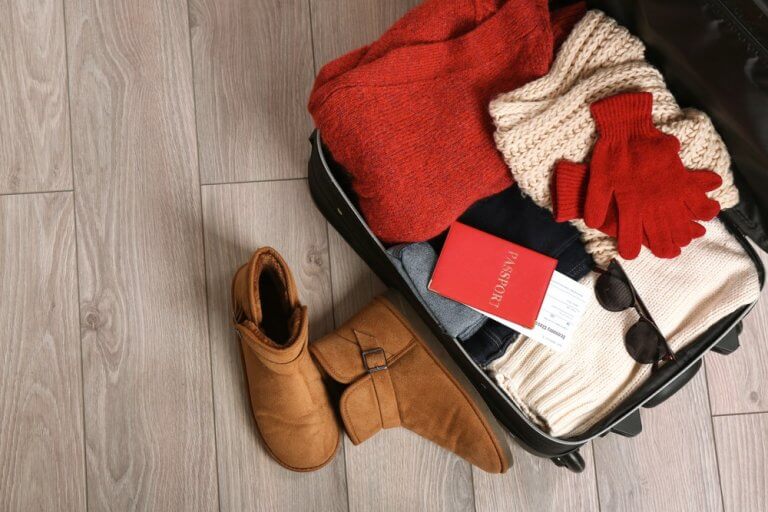
Although it’s generally recommended for international students to begin the school year in the Fall, which is when most of the locals do, sometimes it can’t be helped that students will begin their study abroad journey in the peak of winter.
The winter semesters in the US and Canada, primarily on the East Coast, get notoriously bad weather during the month of January, which is when the semester starts.
Temperatures drop drastically, and blizzards are a common occurrence in certain parts of North America.
If you’re planning to start your first semester during this time, you’ll need to know what to bring so you’re prepared, and what not to bring, so your suitcase isn’t full of unnecessary things that take up precious baggage space.
Here are some tips on what to pack for the winter semester:
Warm clothing

Do you know to dress for the winter? Source: Shutterstock
International students coming from countries that get tropical or subtropical weather all year round, like in Southeast Asia, might find it tough adjusting to harsh winters.
Dressing for winter takes some experience – it’s not as simple as just putting on a jacket. You’ll need a whole new winter wardrobe, and to learn how to dress appropriately so you’re always warm and dry.
Layering is the best way to ensure you’re always warm, so you’ll need more than just a jacket or sweater.
However, you don’t need to pack a full winter wardrobe as you can buy most things you need there, and winter items will probably be cheaper in your host country than back home.
But you’ll still want to be prepared for the first few days and at the very least upon arrival, as you might not be able to go shopping straight away.
Here are a few must-haves to include in your packing list:
- Gloves, a hat, and a scarf
- Long johns and/or leggings
- Jeans and/or other long pants
- Long-sleeved t-shirts
- One or two sweaters or cardigans
- A warm jacket that’s waterproof
- Waterproof, fully-covered shoes or boots
- Thick socks
- Warm sleepwear
- A towel
Medicine and toiletries
You’ll be able to get toiletries in the US or Canada, of course, but you’ll probably need a few things on hand as soon as you arrive.
Going out may be difficult during this time of year due to blizzards, icy roads, and other weather hazards, so make sure you’ve got the essentials.
Pack travel-sized bottles of soap, shampoo, toothpaste, deodorant, lotion, contact lens solution, and other basic amenities. Moisturisers and chapsticks are also definite musts during dry winters, especially if you’re particularly prone to dry skin. Cracked, winter-dry skin can both itch and hurt so do slather on those hydrating creams generously – you won’t regret it!
Also, make sure to pack any prescription medicine you need, as well as allergy medication, in case you need them in an emergency.
Snacks and food

If space permits, pack along some of your favourite local snacks. Source: Shutterstock
Most international students crave and miss their favourite snacks from home while they are studying abroad, so pack some of these if you have room in your luggage.
It can also help to pack some instant noodles, canned soup, biscuits, coffee sachets and teabags in case you reach your new home at an odd hour or can’t get groceries for a few days.
If you plan to cook, you can also bring ingredients that you may not be able to get there easily, such as certain spices, food mixes, bottled sauces or pretty much any condiment in a can or that’s been vacuum-sealed.
Do take note, however, that there are certain types of food products that are prohibited from entry so do always check ahead at the US Customs and Border Protection website.
Documents
Of course, you’ll need your important documents on hand like your passport and visa.
However, you can also bring copies of your birth certificate, award certificates, internship letters, official transcripts and other important documents from your university that you might need, just in case of any immigration foul-up.
If you have any prior medical conditions, it’s also a good idea to bring along medical letters, prescriptions for medicine, blood test results, immunization records, and other medical records that might be useful if you need to visit a doctor during your time abroad.
School supplies
Many international students find that buying school supplies and books are cheaper back home. If that’s the case, make sure to bring just enough for a school year or semester so you aren’t packing too much excess stationery or books.
Other essentials

Sentimental items like family photos can help you feel less homesick. Source: Shutterstock
For your electronic items such as laptop and mobile phone, make sure you bring along a 110-volt adapter that’s compatible with North American outlets.
Other things you might want to bring are a bilingual dictionary or electronic translator, photos of your loved ones in case you get homesick, and your favourite items such as a special piece of jewellery or stuffed toy that reminds you of home.
What not to bring
Bulky non-essential items that you can easily buy there, such as hairdryers, hangers, decorative items, and cooking pots, are probably not worth bringing all the way.
You can buy most of those things when you arrive at stores like Walmart, or online marketplaces like Amazon, so save your baggage space for the truly essential items and things that are close to your heart.
Liked this? Then you’ll love…
What to pack when moving to study abroad
7 mistakes to avoid when packing to study abroad







